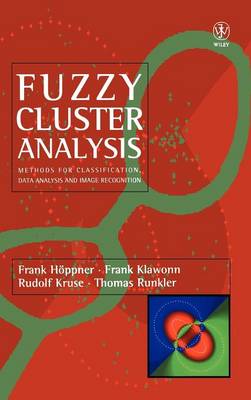Wiley IBM PC
1 total work
Fuzzy Cluster Analysis
by Frank Hoeppner, Frank Klawonn, Rudolf Kruse, and Thomas Runkler
Published 23 April 1999
Provides a timely and important introduction to fuzzy cluster analysis, its methods and areas of application, systematically describing different fuzzy clustering techniques so the user may choose methods appropriate for his problem. It provides a very thorough overview of the subject and covers classification, image recognition, data analysis and rule generation. The application examples are highly relevant and illustrative, and the use of the techniques are justified and well thought-out.
Features include:
* Sections on inducing fuzzy if-then rules by fuzzy clustering and non-alternating optimization fuzzy clustering algorithms
* Discussion of solid fuzzy clustering techniques like the fuzzy c-means, the Gustafson-Kessel and the Gath-and-Geva algorithm for classification problems
* Focus on linear and shell clustering techniques used for detecting contours in image analysis
* Accompanying software and data sets pertaining to the examples presented, enabling the reader to learn through experimentation
* Examination of the difficulties involved in evaluating the results of fuzzy cluster analysis and of determining the number of clusters with analysis of global and local validity measures
This is one of the most comprehensive books on fuzzy clustering and will be welcomed by computer scientists, engineers and mathematicians in industry and research who are concerned with different methods, data analysis, pattern recognition or image processing. It will also give graduate students in computer science, mathematics or statistics a valuable overview.
Features include:
* Sections on inducing fuzzy if-then rules by fuzzy clustering and non-alternating optimization fuzzy clustering algorithms
* Discussion of solid fuzzy clustering techniques like the fuzzy c-means, the Gustafson-Kessel and the Gath-and-Geva algorithm for classification problems
* Focus on linear and shell clustering techniques used for detecting contours in image analysis
* Accompanying software and data sets pertaining to the examples presented, enabling the reader to learn through experimentation
* Examination of the difficulties involved in evaluating the results of fuzzy cluster analysis and of determining the number of clusters with analysis of global and local validity measures
This is one of the most comprehensive books on fuzzy clustering and will be welcomed by computer scientists, engineers and mathematicians in industry and research who are concerned with different methods, data analysis, pattern recognition or image processing. It will also give graduate students in computer science, mathematics or statistics a valuable overview.
